Cabinets 101: A Beginner’s Guide to Choosing Cabinets for Your Home
April 24, 2025
Cabinets 101
Cabinets play a major role in both the function and style of any renovation, but with so many options to consider, the decision process can feel daunting. Stock or Custom? Framed or frameless? Inset, partial, or framed overlays? It’s easy to feel overwhelmed, but this guide will walk you through the basics to help you make informed choices for your home and find the right cabinets for your space and style. Welcome to Cabinets 101!
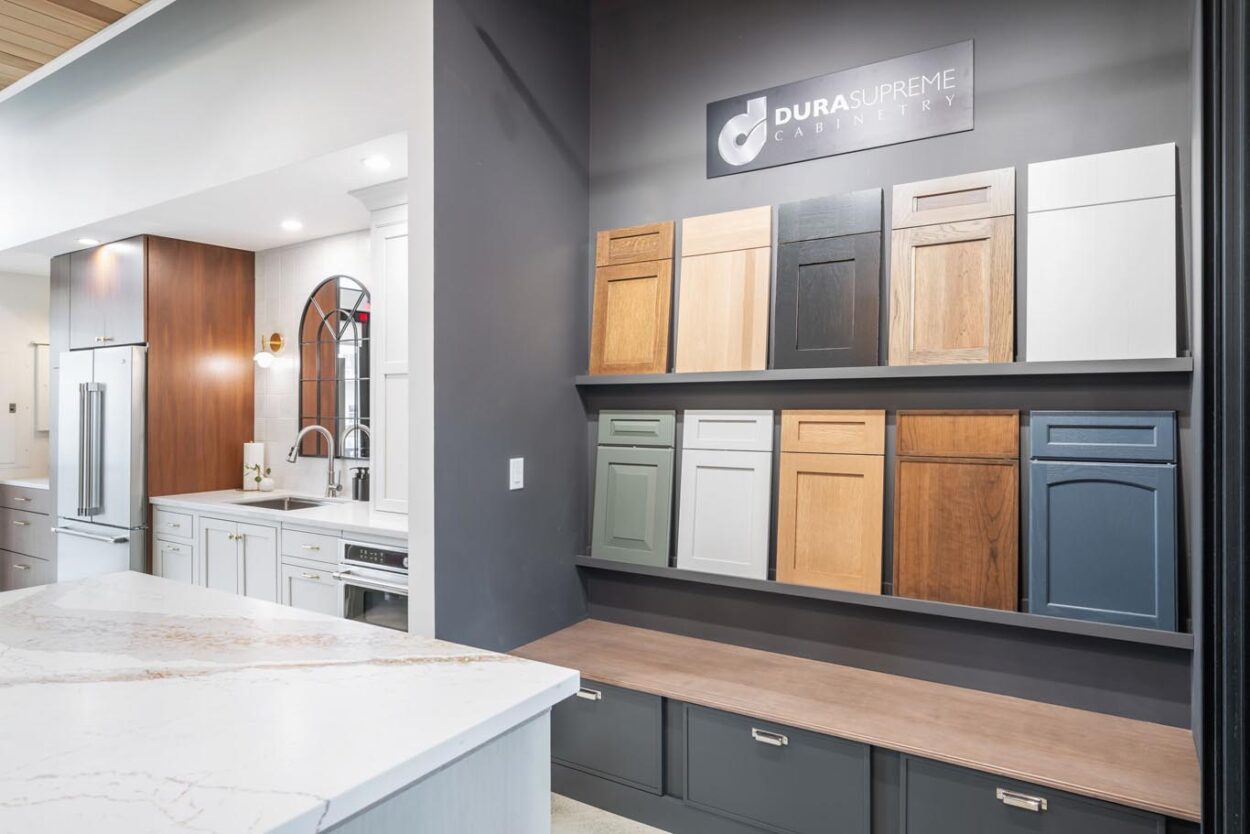
Stock Cabinets vs. Custom Cabinets
When it comes to the overall look of your new cabinetry, you may first be met with the choice of prefabricated, stock cabinets or custom cabinets. Stock cabinets are pre-designed and manufactured in standardized sizes which allows for a quicker and more budget-friendly option.
On the other hand, custom cabinets are made to specific dimensions and design preferences, which provide more flexibility and higher quality albeit at a greater price point as well as the possibility of a longer production time frame. To help you determine which may be more preferable for you, here is a list of pros and cons for each, which you can apply to your own planning, budget, and overall vision.
Stock Cabinets
Pros:
- Cost-effective: In general, stock cabinets are cheaper than custom cabinets.
- Faster availability: They are typically readily available, reducing lead time.
- Easier to select and install: The standardized sizes and designs make the selection process simpler.
Cons:
- Limited design options: These designs are readily available however you are limited to predefined styles, sizes, and materials.
- May not fit unique spaces: They might not accommodate irregular layouts or specific storage needs which can lead to undesired design challenges.
- Potential quality issues: Some stock cabinets may use lower-quality materials as they are mass produced.
Custom Cabinets
Pros:
- Design flexibility: If you can dream it, you can do it. You can customize every aspect, including size, shape, color, and material.
- Space optimization: They can be designed to perfectly fit your space, maximizing storage.
- Higher quality: Often made with better materials and craftsmanship.
Cons:
- Higher cost: Custom cabinets tend to be more expensive than stock cabinetry.
- Longer lead times: Custom cabinets are made to order and production will add time to your project.
- Requires more planning: A consultation with a professional is often needed to determine exact measurements and design.
Ultimately, when identifying key differences between stock and custom cabinetry, stock may be a more well-suited option for budget-conscious renovations, quick installation, and a less complex process. Opt for custom cabinets when design flexibility, space optimization, and high-quality materials are priorities, and you are willing to invest more time and money.
Frameless or Framed Cabinets
For overall aesthetics, frameless cabinets offer a more modern, sleek look and provide greater storage space compared to framed cabinets, which tend to have a more traditional appearance. Frameless cabinets are also known as “full access” or “European style” due to their lack of a face frame, allowing for easier access to the interior. Let’s look at some pros and cons of framed and frameless cabinet options.
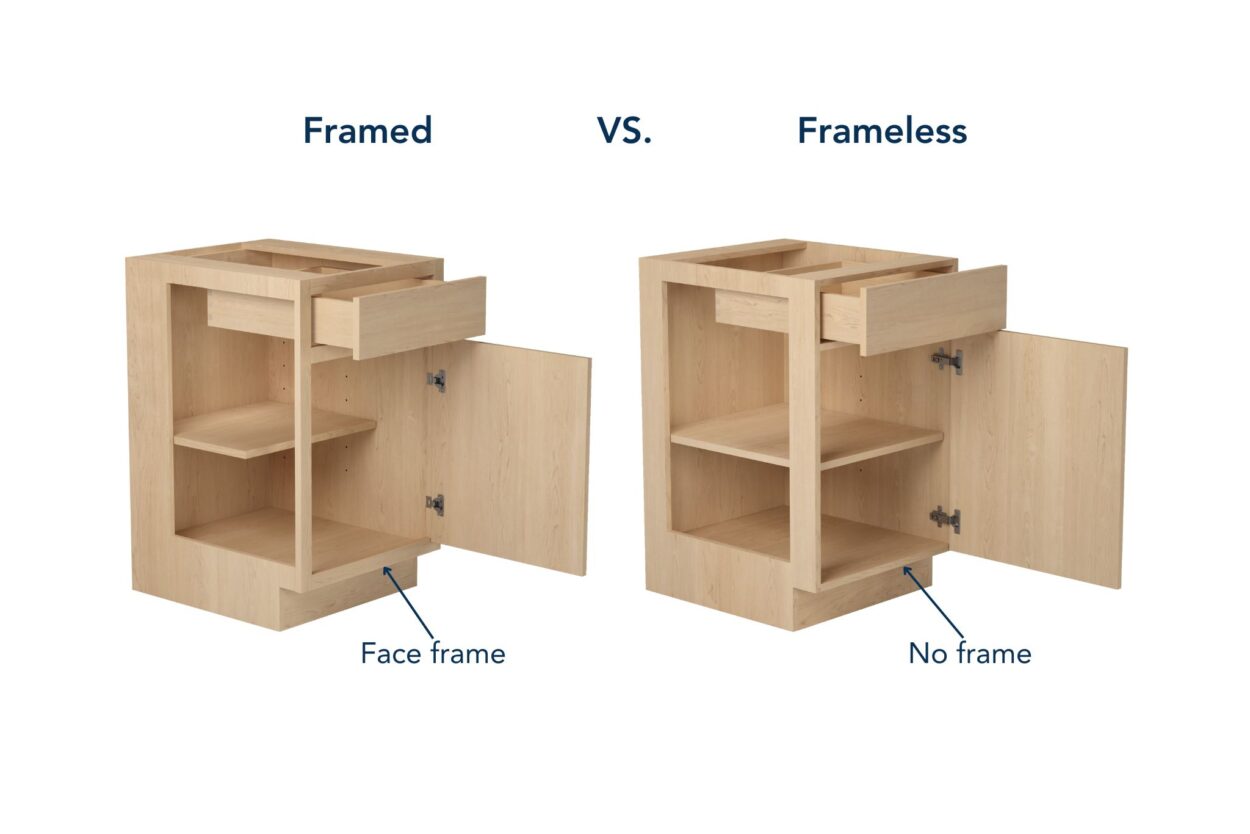
Frameless Cabinets
Pros:
- More storage space: Eliminating the face frame provides at least an extra inch of depth, allowing for larger drawers and more efficient use of space.
- Sleek, modern look: The lack of a frame creates a clean, minimalist aesthetic.
- Full access: The absence of a face frame also makes it easier to reach items in the back of the cabinet.
- Easier organization: Can accommodate various organization options, including roll-out shelves and other storage customizations.
- Versatile: Can complement various design styles, from modern to traditional.
- Customization: Frameless cabinets tend to offer more flexibility in material and finish options.
Cons:
- Limited door overlay options: Typically only come in full overlay, meaning the doors cover the entire cabinet opening.
- Higher installation precision required: Installation can be more challenging due to the lack of a frame to hide minor imperfections.
- Potential for more expensive materials: May require more expensive materials to ensure durability.
- Cost: Frameless cabinets may be more expensive than framed cabinets.
Framed Cabinets
Pros:
- Traditional appearance: The face frame adds a classic, more traditional look.
- More door overlay options: Can accommodate inset, partial-overlay, or full-overlay doors.
- Easier installation: The face frame can help hide minor imperfections and makes installation easier.
- Potential for lower cost: Can be less expensive than frameless cabinets.
Cons:
- Less storage space: The face frame takes up some space, reducing the amount of usable storage compared to frameless cabinets.
- Less sleek look: The face frame can make the cabinet look less modern.
- Potentially more difficult to reach items in the back: The face frame can make it harder to access items in the back of the cabinet.
Cabinet Box Construction Materials
Cabinet boxes are the bones of your cabinet system. They are typically constructed using engineered wood products like plywood, MDF (Medium Density Fiberboard), or particle board, but can also incorporate solid wood, stainless steel, or other materials. The choice of your cabinet’s materials depends on factors like budget, desired durability, and aesthetic preferences.
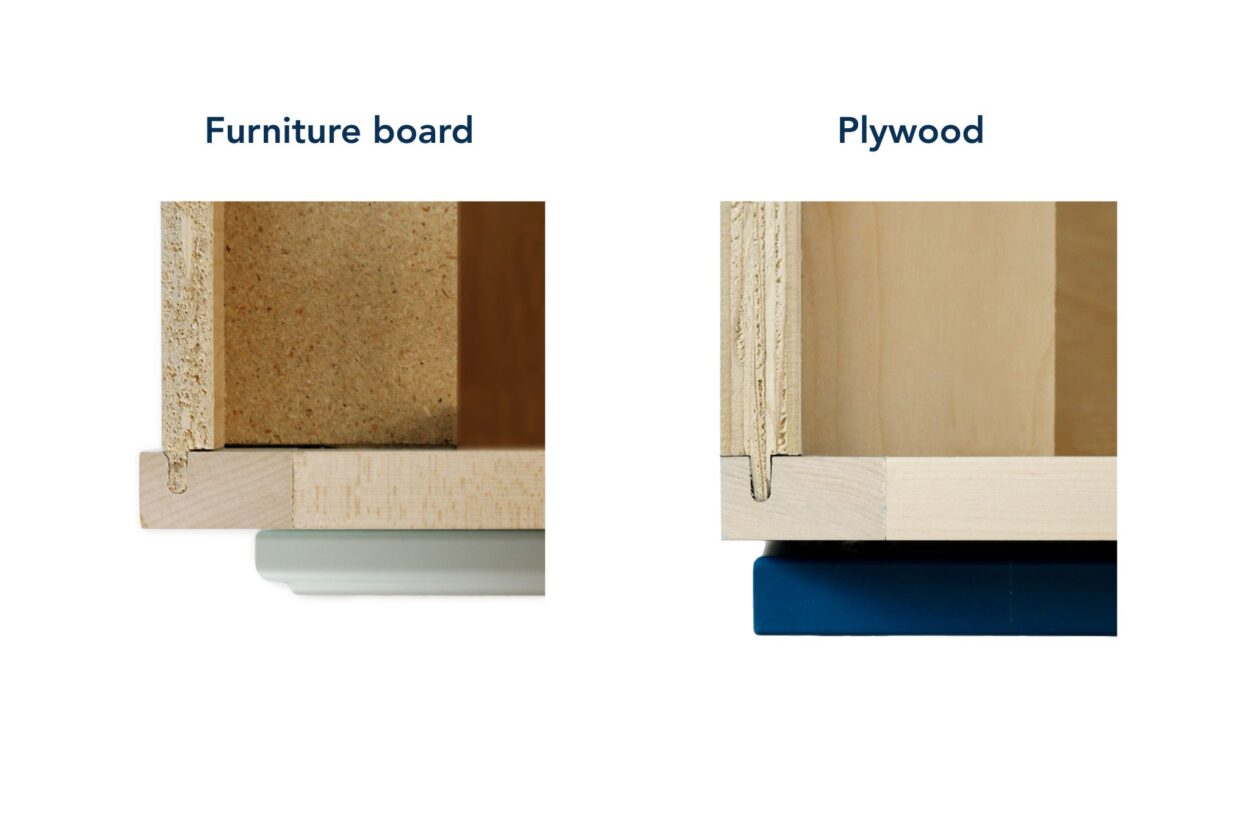
Common materials include:
- Plywood: Plywood is a popular choice due to its strength, stability, and resistance to warping, making it suitable for holding heavy items and supporting countertops. It’s also more durable than particle board.
- MDF (Medium Density Fiberboard): MDF is another common choice, particularly for cabinet boxes and interior shelves, offering a smooth surface ideal for painting. It’s also known for its dimensional stability, resisting expansion due to temperature and humidity changes.
- Particle board: Particle board is an economical option, but it may be less durable than plywood or MDF, and can be more susceptible to moisture damage.
- Solid wood: Solid wood, such as oak, maple, or cherry, is often used for doors and frames, offering a traditional look and durability.
- Stainless steel: Stainless steel is a durable option, often used for commercial and industrial applications where strength and resistance to corrosion are crucial.
Other considerations also include:
- Construction methods: Cabinet boxes are typically constructed using a variety of joinery techniques, including dowels, screws, glue, or nails.
- Veneers and finishes: Cabinet boxes can be covered with wood veneers or laminates to enhance their appearance and provide a protective surface.
- Cost: Engineered wood products like plywood and MDF are generally more cost-effective than solid wood, while particle board is the most budget-friendly option.
Full, Partial, Inset Overlays
In cabinet design, overlay options refer to how much of the cabinet frame is covered by the door or drawer front. For instance, full overlay covers the entire frame, creating a continuous, sleek look, while partial overlay leaves some of the frame visible, offering a more traditional appearance. Inset cabinets feature doors that sit within the frame, flush with the cabinet face, providing a clean, continuous look similar to full overlay, but with a slightly different aesthetic.
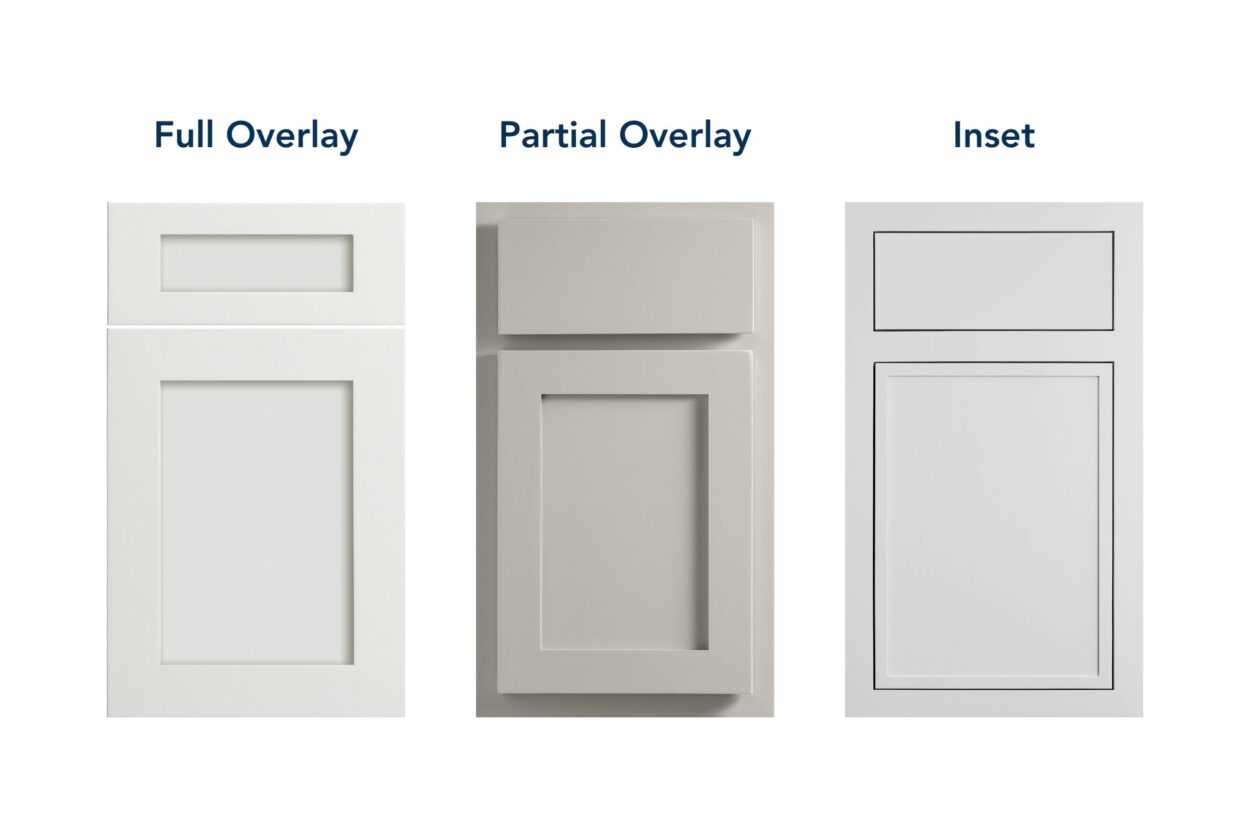
Full Overlay
- Appearance: Doors cover the entire frame, creating a smooth, sophisticated and continuous look.
- Cost: Generally less expensive than inset cabinets due to simpler construction and less material used.
- Storage: Offers slightly more storage space than inset cabinets as doors don’t need to fit within the frame.
- Durability: Doors may be more vulnerable to damage as they are more exposed.
- Aesthetics: Often associated with modern or transitional styles.
Partial Overlay
- Appearance: Doors only cover part of the frame, revealing the cabinet frame between doors.
- Cost: Typically the most budget-friendly option.
- Storage: Offers a good balance of storage space and aesthetics, with a slight trade-off compared to full overlay.
- Durability: More durable than full overlay due to the frame providing more protection.
- Aesthetics: Often associated with traditional styles.
Inset
- Appearance: Doors fit within the frame, creating a flush, continuous look.
- Cost: The most expensive option due to precise measurements and craftsmanship required for installation.
- Storage: Offers slightly less storage space than overlay cabinets as doors are recessed within the frame.
- Durability: Doors may be more vulnerable to wear and tear due to friction with the frame.
- Aesthetics: Often associated with traditional or transitional styles.
Raised, Flat and Slab Panel Doors
Raised panel interior doors offer a classic, sophisticated look and are often considered more durable and less prone to warping than flat or slab panel doors. Flat panel doors provide a modern, sleek aesthetic and are typically more affordable and easier to maintain. Finally, slab cabinet doors are flat panel doors that have no ornamentation or beveling. Slab doors create the smooth, clean, uncomplicated lines of contemporary design.
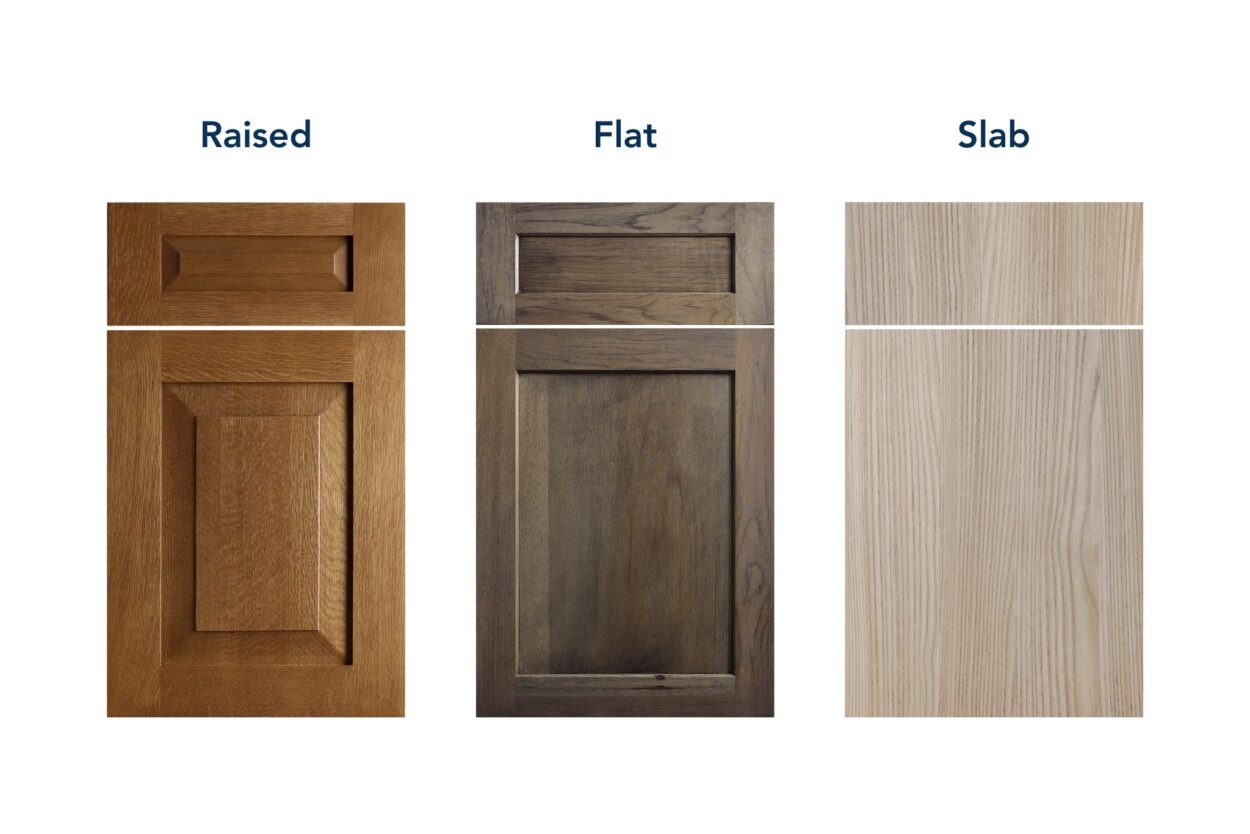
Raised Panel Doors
- Aesthetic: Add depth, texture, and a traditional or formal look.
- Durability: Generally more durable and less prone to warping.
- Cost: Typically more expensive than flat panel doors.
- Maintenance: May require more effort to clean due to the raised panels and grooves.
- Versatility: Can complement various kitchen styles, from traditional to transitional.
Flat Panel Doors
- Aesthetic: Offer a modern, sleek, and minimalist look.
- Durability: May be more susceptible to warping, especially in humid environments and dependent on materials used.
- Cost: Generally more affordable than raised panel doors.
- Maintenance: Easy to clean due to their smooth surfaces.
- Versatility: Well-suited for contemporary and minimalist designs.
Slab Panel Doors
- Aesthetic: Smooth look, contemporary and modern style. Slab cabinet finishes tend to be either natural wood or a bold, dramatic color.
- Durability: Also susceptible to warping, especially if they are built from single pieces of wood. Plywood-core doors, though, are dimensionally stable. Even single slab MDF will resist warping as long as the laminate or thermofoil covering remains intact. Solid hardwood, too, if properly sealed with stain or paint, will be less prone to warping.
- Cost: Often the most expensive however, materials ultimately determine the cost—the most expensive and durable option is probably solid hardwood. Next, Class A Furniture Plywood, which are finish-grade plywood panels in which the face layer is a high-quality hardwood applied over cheaper ply. Finally, MDF is a standard material used for doors that will be painted or as the core layer for doors covered with plastic laminate or thermofoil.
- Maintenance: Easy to clean with smooth surface and no beveling.
- Versatility: Timeless appearance that blends well with other styles.
Customization Examples
On top of the options above, many cabinet lines offer add-ons, accessories, or extra customizations to personalize your new cabinetry for your specific storage needs. Think wine storage options, appliance garages, and baking stations. Commonly, there are cutlery and silverware storage inserts for top drawers and deep set drawers designed to efficiently store dishes and bowls. There are even some options to mount accessories inside cabinet doors as well as various pull-out systems to better organize spices, cutting boards, bakeware, and even garbage/recycling.
Customizations are not limited to what you put in your cabinets either, some options include unique shaped cabinetry to fit unorthodox spaces and angles in your office or home, where you want to add additional storage. Ultimately, these customizations are meant to help transform your space and better suit your needs.
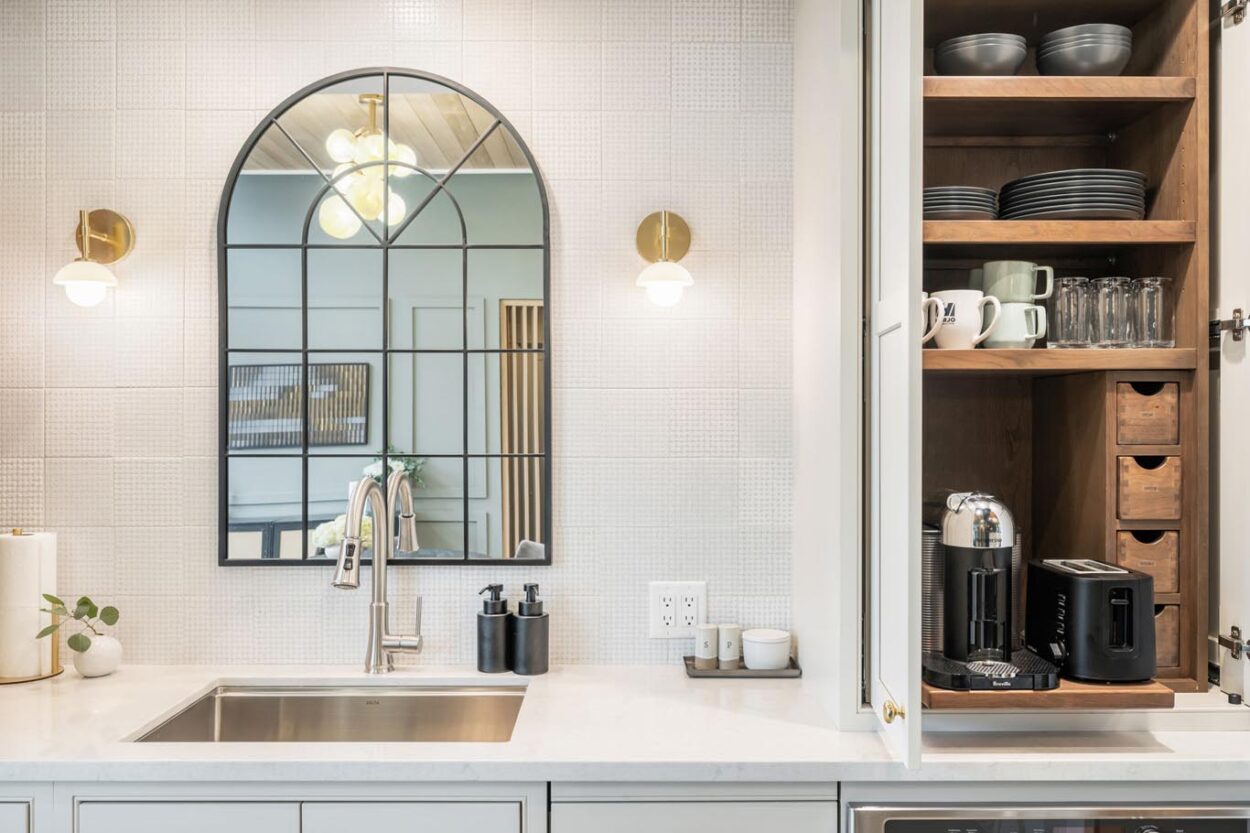
Finishes
Appropriately, let’s wrap up with decisions you may face when choosing your cabinet finishes. Finishes can dramatically influence the overall look and feel of your space, and the options go far beyond paint or stain.
If you’re drawn to the natural beauty of wood, you can highlight it with a clear finish or choose from a wide range of stains that enhance grain patterns and deepen color tones. Different wood species like oak, maple, walnut, and cherry each offer their own unique characteristics, from visible texture to warm undertones.
For a more uniform or colorful look, painted finishes are a timeless choice. You can choose from standard paint palettes or go fully custom with any color under the sun. Finishes range from satin and semi-gloss to matte, depending on your preferred sheen and durability needs.
For a more modern or low-maintenance option, there’s a wide range of engineered materials and specialty finishes. TFL (Thermally Fused Laminate) is a budget-friendly and durable surface with consistent color and texture. Matte foil and high-gloss acrylics are sleek, contemporary finishes that offer a smooth, clean appearance in either subdued or high-impact colors. There are also textured laminates and wood veneers that provide the warmth of wood grain with more consistency and stability, available in everything from subtle neutrals to bold, dramatic tones.
Whether you’re aiming for a rustic farmhouse feel or a minimalist modern look, the right finish ties everything together and sets the tone for your space. And don’t forget the hardware — knobs and pulls in finishes like brass, matte black, or brushed nickel are the perfect final touch to reflect your style.
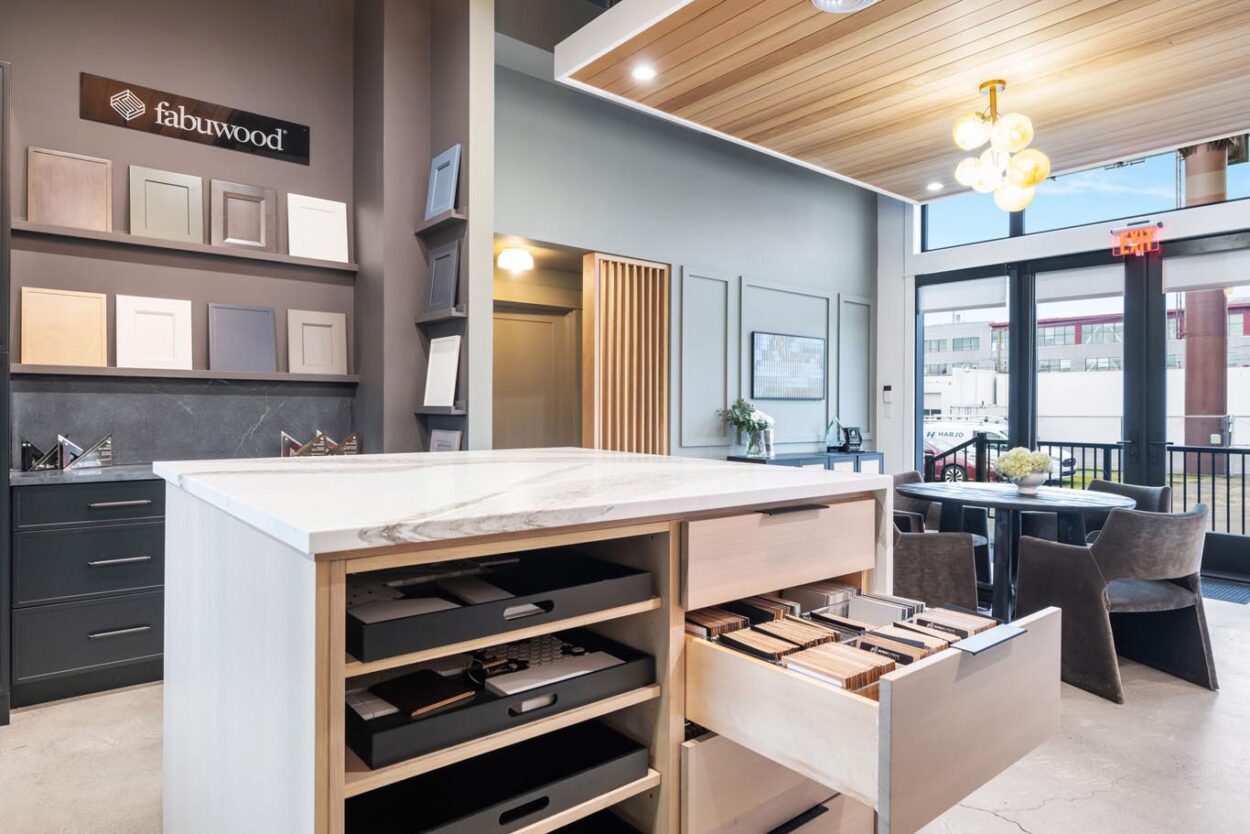
Next Steps
If you are looking for high quality custom cabinets to elevate your home, we’ve got you covered. Whether you’re a DIY homeowner, a local Seattle builder, architect, or interior designer in need of reliable cabinetry solutions, our team specializes in offering expertly designed cabinets to suit your style and vision—from kitchens and bathrooms to mudrooms, laundry areas, and beyond. We understand that cabinets are more than just storage, they’re a key part of your home’s design and functionality. Reach out to our team if you have any questions. Already have a project in mind? Fill out our contact form to schedule a free consultation! We’re so excited to help you find the cabinets that are perfect for you and your home!